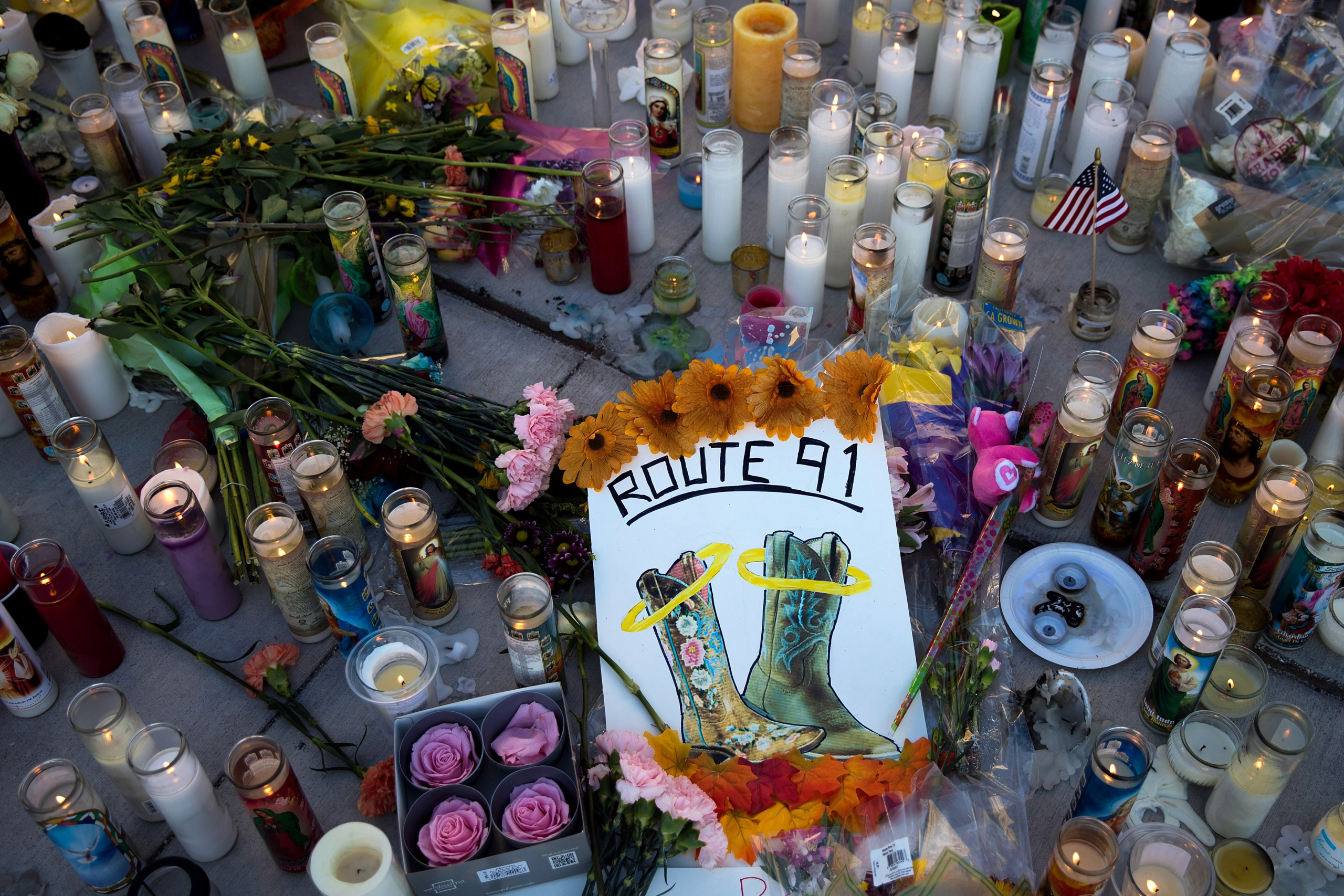When tragedy strikes, reporters and editors agonize over the words they’ll use to usher bad news into the homes of readers. Those word choices—made large, bold, and splashed across front pages—are intended to communicate an event of high significance, something so out of the ordinary it deserves your immediate attention. The headlines intend to startle, because the events they describe are startling.
What happens when those significant events, once rare, become cyclical? What happens when large-scale gun deaths like Sunday’s terror in Las Vegas become so common that headlines and layouts used to convey their gravity serve as templates, ready for the next massacre? Is the Onion’s repeated republishing of a satirical article about the inevitability of mass shootings still satire when it is no longer a caricature but actual news?
ICYMI: The first reporter to arrive at Vegas gunman’s house has covered the story in many ways–except one
CJR looked at the language that newspapers around the country, and outside of the US, used to report on the violent deaths of 59 concertgoers—and the injuries caused to many hundreds more—at the Route 91 Harvest Music Festival on the Las Vegas strip. We focused primarily on front-page headlines and subheadlines, but also paid close attention to photo captions and pull-quotes. Then we compared the way newspapers reported on five other recent mass shootings in the US, at Orlando’s Pulse nightclub (2016); a social services office in San Bernardino, California (2015); a historic black church in Charleston, South Carolina (2015); Sandy Hook Elementary School in Newtown, Connecticut (2012); and at a movie theater in Aurora, Colorado (2012).
What we found was an unsettling repetition of superlatives. Reporters pegged the Pulse nightclub shooting as the worst in American history, despite several older tragedies that often go unacknowledged (and in which victims were predominantly people of color) and saw a greater loss of life. On Monday, Las Vegas was deemed the new “worst” mass shooting, and while some newspapers did adjust their wording to note that it set the new record for the worst in modern American history, many others did not.
We saw familiar treatment of white men who commit violent crime, such as the swift use of labels like “lone-wolf,” and a hesitation to describe what happened in Vegas as terrorism. This hesitation was not seen in coverage of the Orlando and San Bernardino mass shootings, where the shooters were not white men. (Though in Charleston, where the victims were black and the shooter was a known white supremacist, media again wrangled over use of the term.) Some coverage included positive descriptions of the Vegas gunman Stephen Paddock, and included adjectives such as “retiree.”
Newspapers repeatedly used words like “carnage” and “evil” to characterize the shooting—the same descriptors used for other mass shootings in recent memory. Many outlets quoted President Trump, echoing his description of the tragedy as “pure evil.” Similarly, newspapers often quoted former President Barack Obama in the wake of the Orlando and Newtown tragedies. In covering Las Vegas, elected officials and law enforcement around the country have expressed a sense of resignation over the inevitability of these devastating events; that fatalism has seeped into news coverage, too, as newspapers including in areas like Lynchburg, Virginia quoted the Las Vegas sheriff prominently: “I don’t know how this could have been prevented.”
TRENDING: Site sparks uproar on social media with Vegas massacre headline
As mass shootings become an increasingly common fixture of American life, and subsequently of American news coverage, journalists are uniquely poised to help shake the public discourse as repeat traumas threaten to desensitize us. Journalists should continue to rigorously report the details and developments of mass shootings and subsequent investigations, while working to honor the dead. Push forward the inevitable debate on gun control. Challenge academics who shy away from conducting the kind of research that could nudge conversations about policy forward. And push back against sources who criticize the so-called politicization of the issue; access to guns, a constitutional right, is inherently political. When we consider these mass shootings not as isolated events but as a predominantly American phenomenon, what’s more shocking than their occurrence is that in addressing them, both politically and in terms of news coverage, nothing changes.
Below, a roundup of front page coverage of the Las Vegas shooting from around the country and world.

The Mercury News, San Jose, California
The Mercury News said what we were all thinking in its main headline, but featured a pull-quote from Vegas gunman Stephen Paddock’s brother above the fold: “(My brother was) not an avid gun guy at all. If he had killed my kids, I couldn’t be more dumbfounded. The fact that he had those kind of weapons is just—where the hell did he get automatic weapons?” The compulsion to understand and explain the motives behind such acts of violence is understandable and, ultimately, part of our job as reporters. But dedicating such high-value real estate to words that, intentionally or not, may soften a man who has committed a horrible crime—and works to isolate his behavior as something that cannot be understood in the context of the larger phenomenon of mass shootings—is risky. A quote from a concertgoer appears last in the sidebar, below remarks from Paddock’s brother, President Trump, and a police officer on a 911 call.
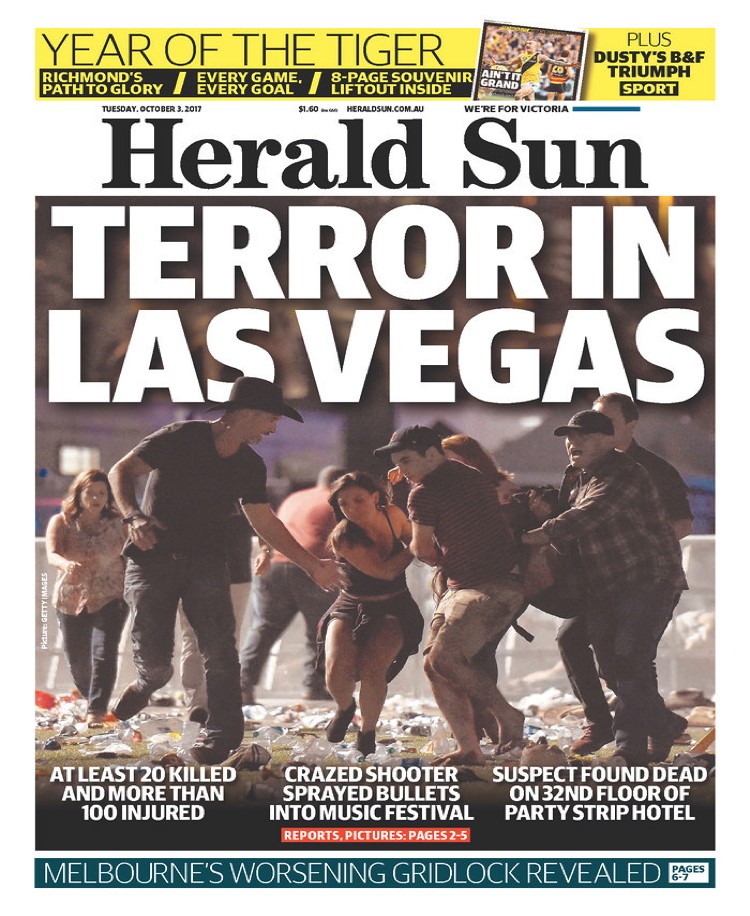
Herald Sun, Melbourne, Australia
Australia is often invoked as an example of a Western nation that saw declines in mass shootings after major gun control reforms. Over a photo of concertgoers carrying away the injured, Melbourne’s Herald Sun vastly underestimates the Vegas death toll while describing the event as “terror,” and the shooter as “crazed.”

Miami Herald, Miami, Florida
The paper’s headline quotes President Trump’s remarks from the White House on Monday. Many newspapers opt to quote the president and other officials as they weigh in on mass shootings. President Trump has botched his responses to crises in the last month, including hurricanes in Texas, Florida, and Puerto Rico, but here, he offered a quote deemed worthy of leading coverage by many newspapers.

Chicago Sun-Times, Chicago, Illinois
The Sun-Times led with the central question of its editorial, pointedly taking a position and filling much of the page with a black background. As newspapers grapple with accusations of biased coverage and the evolving idea of objectivity, the Sun-Times demonstrates a powerful way to report the day’s events: hold to the fire the feet of officials and readers alike, all while pushing an important conversation forward.
In 2016, after the Pulse nightclub shooting left 49 people dead, the Orlando Sentinel published a heartfelt sermon on its front page directly addressing readers and imploring the community to work together to survive the grief—and prevent a repeat—of such an attack.
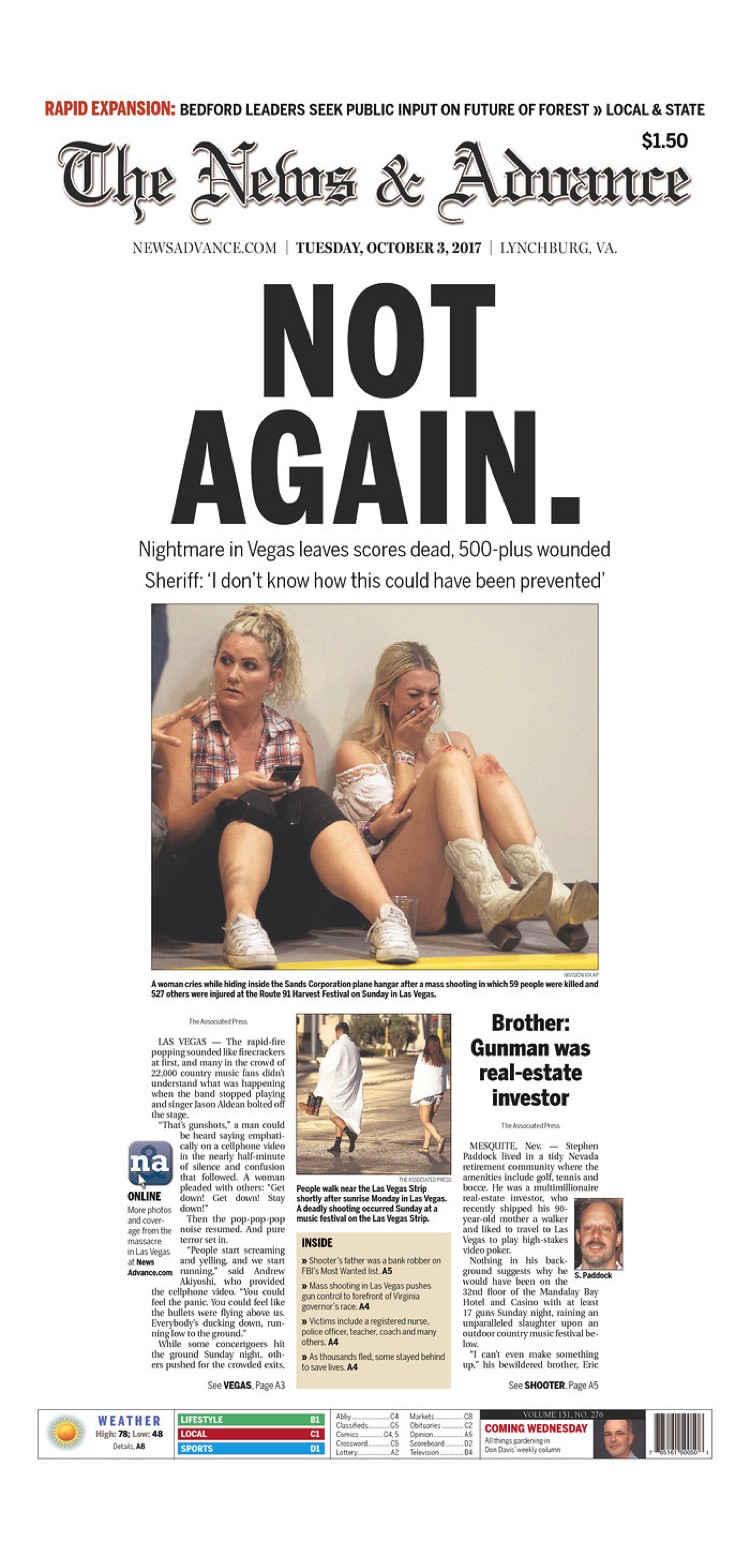
The News & Advance, Lynchburg, Virginia
In Lynchburg, Virginia, The News & Advance emphasizes officials’ resignation to the inevitability of devastating mass shootings in the US. That sentiment is given prominent display in the form of a subhead, but risks parroting claims of helplessness common in debates about gun control after mass shootings. Limited space on front pages poses a challenge to designers and editors who must make these decisions.
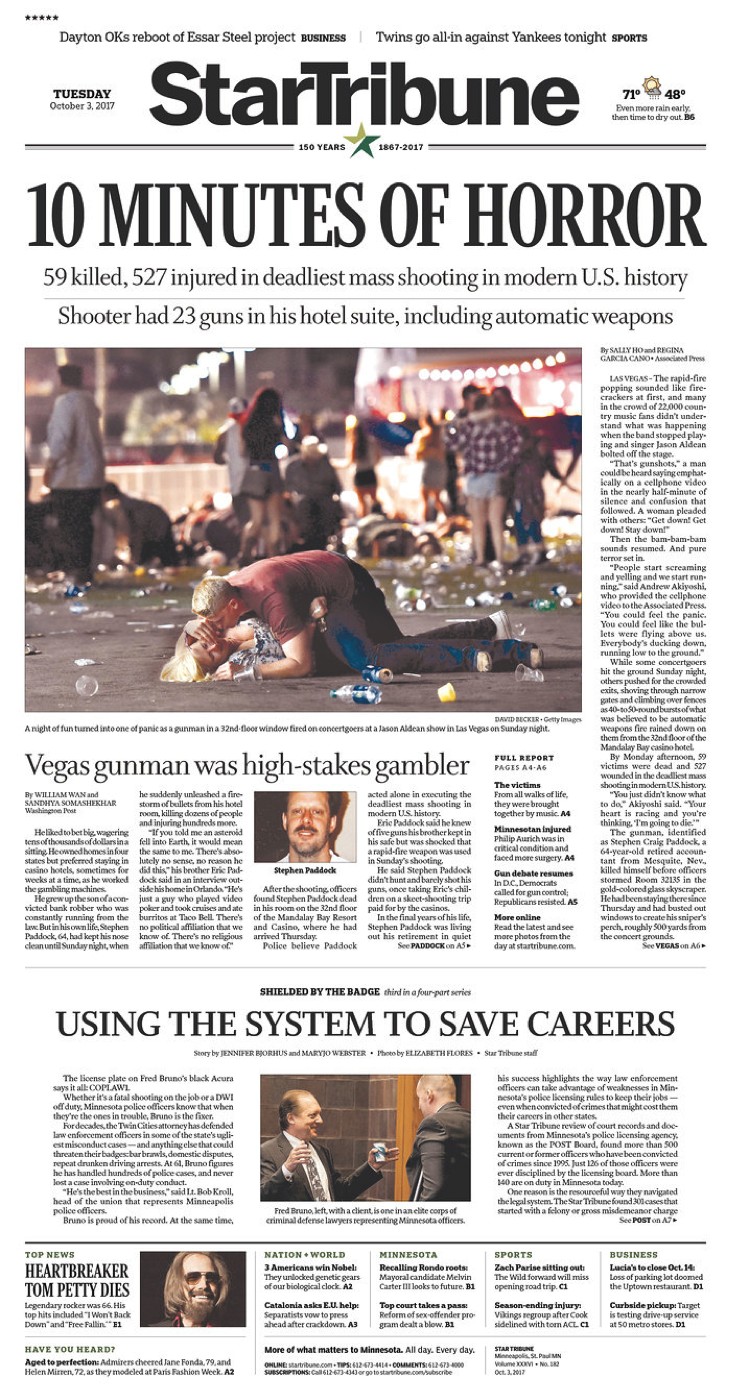
StarTribune, Minneapolis, Minnesota
This headline broke away from the trends, focusing on how long the shooting continued for and the number of injured and killed. The StarTribune also used the more accurate phrase “modern U.S. history” and mentioned the role of automatic weapons. Informing readers of the immense loss of human life and immediately reminding them of the minuscule amount of time it took for so many to be massacred provides sobering context.

The Globe and Mail, Toronto, Canada
Interestingly, the simple headline used by this Canadian national newspaper could apply to any mass shooting in the United States. It only specifies the location of the shooting in the headline of one of the articles below the lead photo. The number of injured and killed is stated the photo caption, as well as in the second paragraph of the first article.
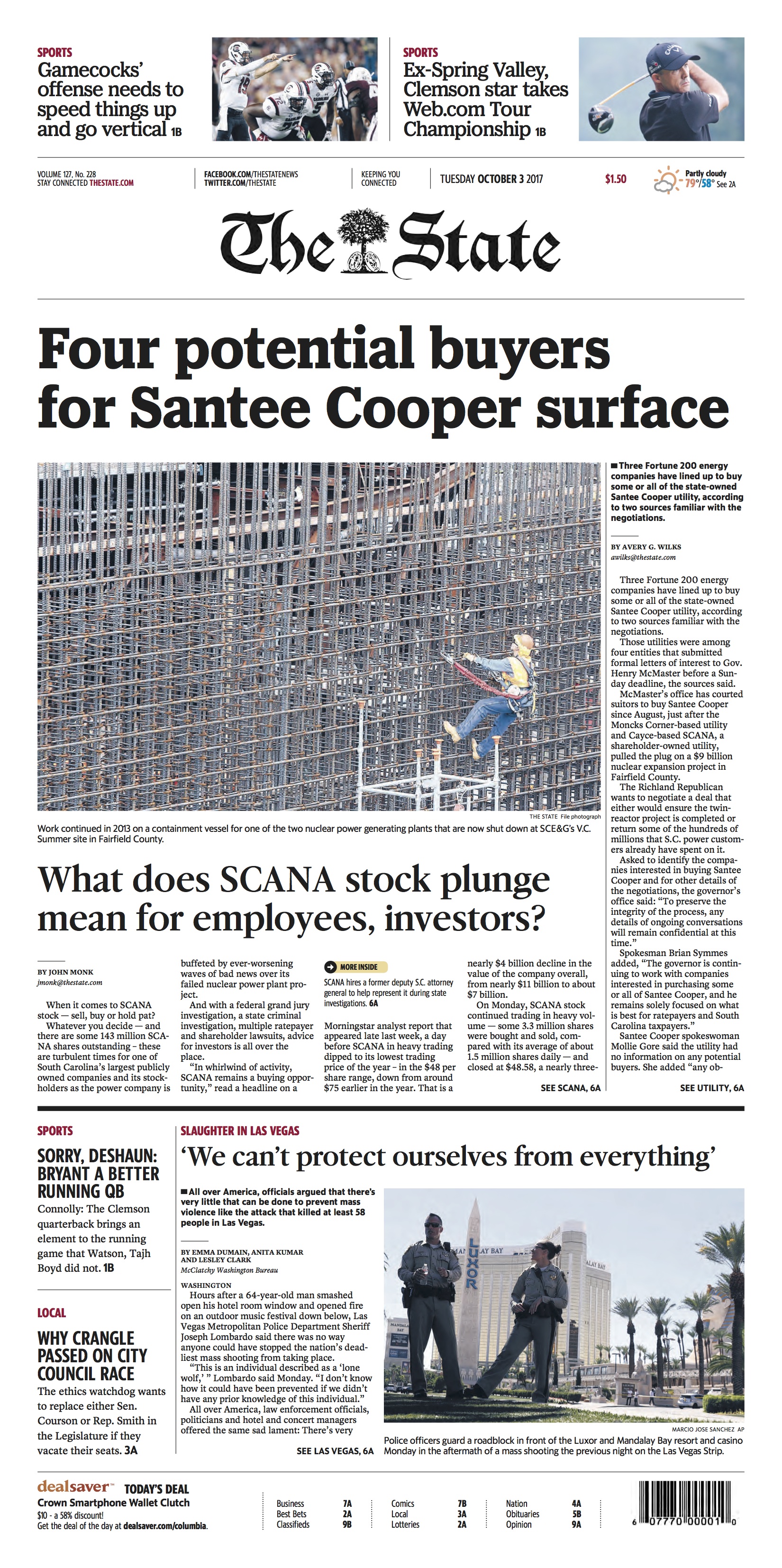
The State, Columbia, South Carolina
The Vegas shooting doesn’t feature prominently on the cover of Columbia’s The State. Rather than running an image of the attack or vigils honoring the dead, the paper ran a McClatchy story titled, “We can’t protect ourselves from everything.”
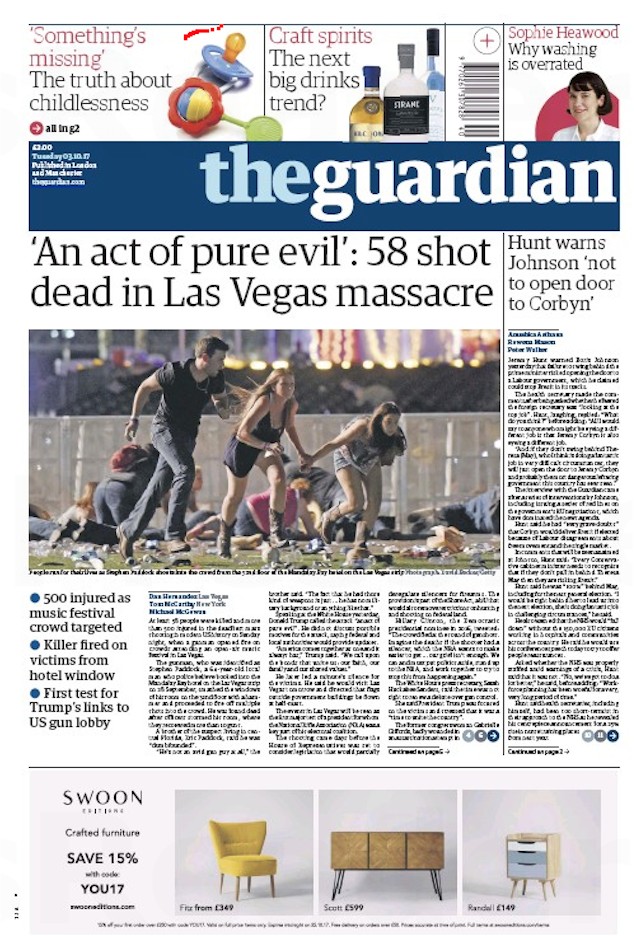
The Guardian, London, England
The Guardian was one of few newspapers to directly pull the Vegas rampage into ongoing scrutiny of President Trump’s administration, suggesting in a subhead that the tragedy could be the first stress test of Trump’s ties to the powerful gun lobby.
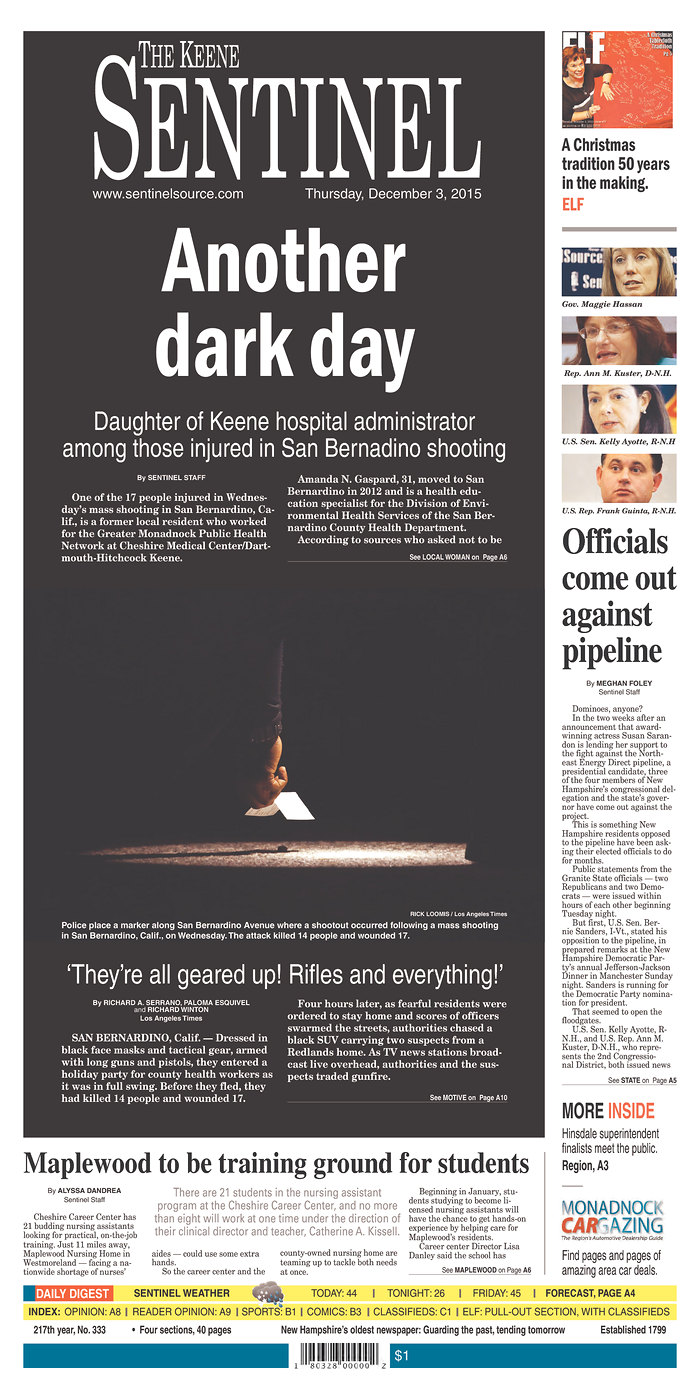
The Keene Sentinel, Keene, New Hampshire
In 2015, New Hampshire’s The Keene Sentinel used a headline to communicate public fatigue with repeat mass shootings after 14 people were shot to death at a company holiday party.
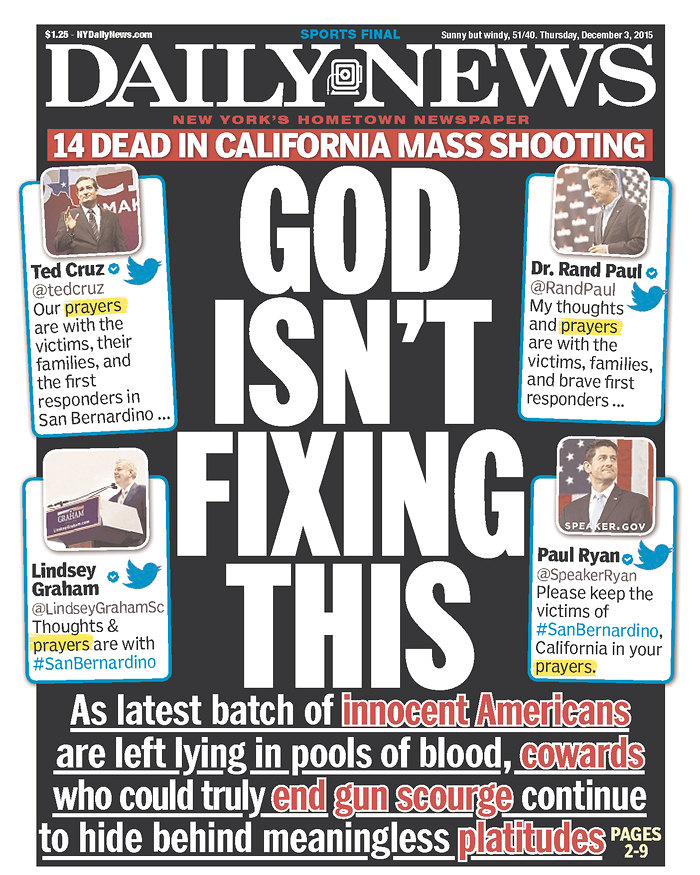
Daily News, New York, New York
The New York Daily News published a provocative cover after the San Bernardino shooting in 2015, challenging common calls for unity and prayer in the wake of mass shootings.
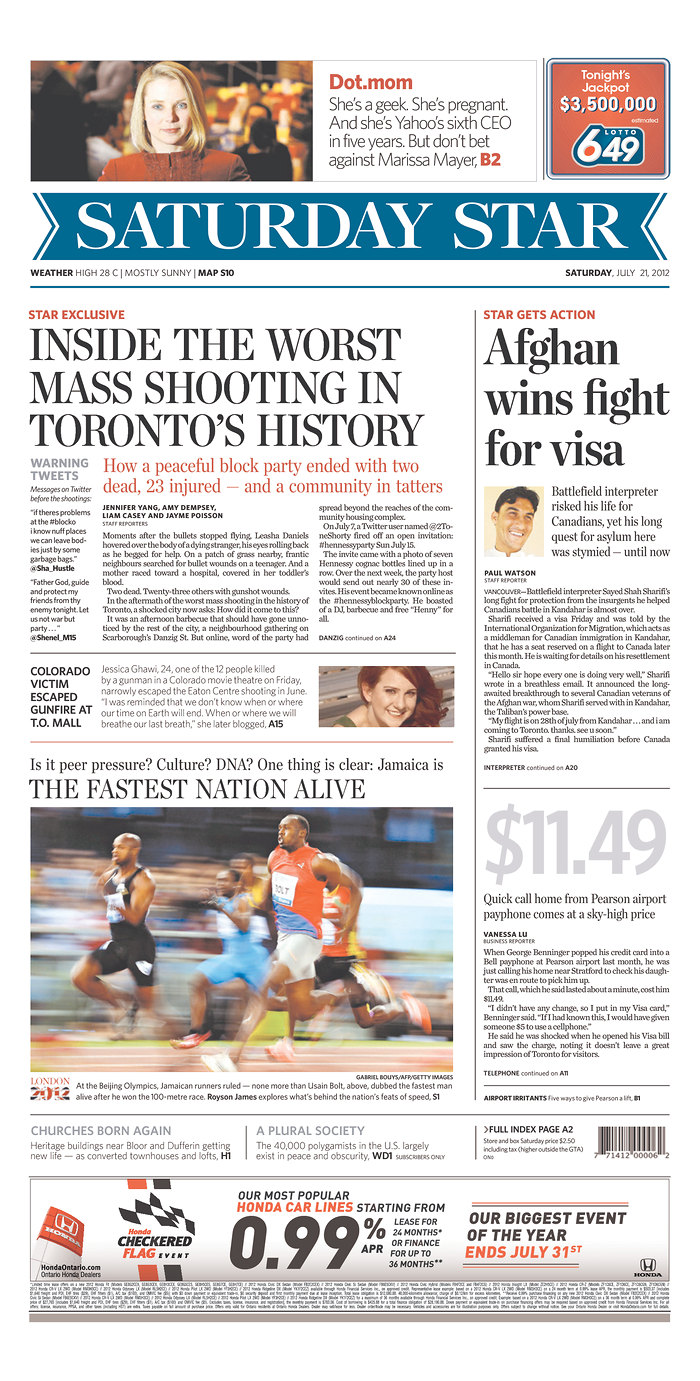
The Toronto Star, Toronto, Canada
One day after James Holmes walked into a midnight screening of The Dark Night in an Aurora, Colorado, movie theater and shot 12 people dead and injured 70 others, this Toronto newspaper ran a cover about what was dubbed the city’s worst mass shooting, which left two dead and 23 injured. The contrast is startling; gun violence of a similar scale happens regularly in American cities like Chicago, but rarely captures national attention, displaying inconsistencies in the way the public and the media label shootings that involve multiple fatalities. Another Canadian newspaper, the Globe and Mail, ran a cover story the same day detailing several of that country’s mass shootings of the era. The Aurora, Colorado movie theater shooting gets a shoutout, too.
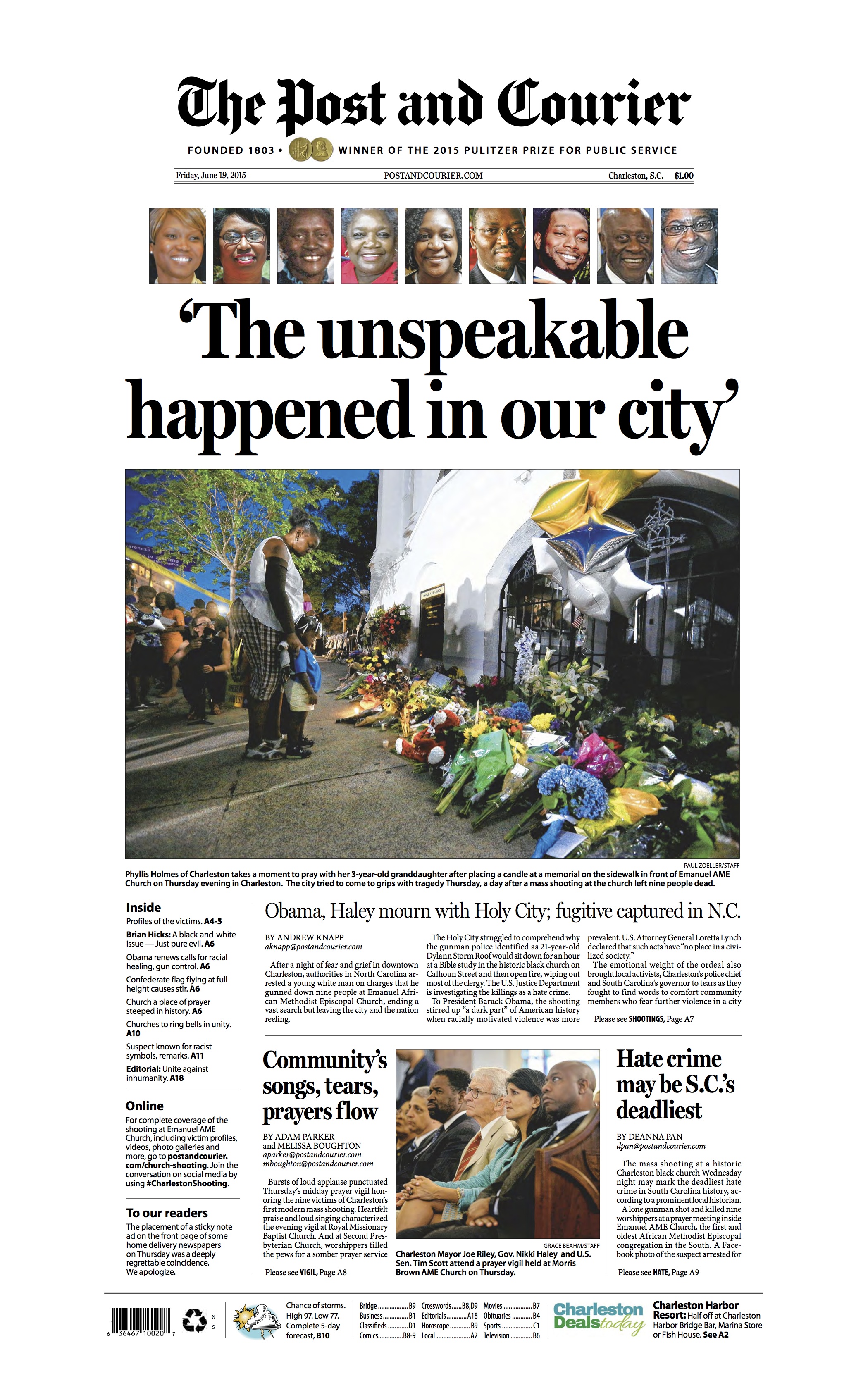
Post and Courier, Charleston, South Carolina
News media around the country found themselves the subject of scrutiny in the aftermath of Dylann Roof’s racist assault on parishioners at a historic black church in Charleston. While other papers focused their attention on the shooter, the Post and Courier prominently ran photos of each of the nine victims. The paper was also not shy in immediately labeling the deadly shooting a hate crime in a story headline below the fold, even as journalists elsewhere hesitated to use that and other terms, such as “domestic terrorism,” to describe the violence. Consider Columbia, South Carolina’s The State, which focused primarily on Roof, running his name in a prominent headline and a photo of him below the fold.
RELATED: The phrase journalists used to describe Vegas shooter, and the ‘unspoken implication’
Karen K. Ho and Alexandria Neason are CJR staff members. Ho is a CJR Delacorte Fellow. Follow her on Twitter @karenkho. Neason is CJR's Senior Staff Writer. Follow her on Twitter @alexandrianeas.

